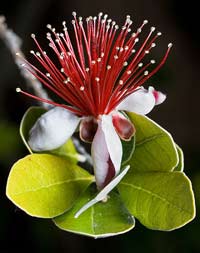Drought-Tolerant Fruits
Figs, Pineapple Guava, and Loquats Are a Few Fruits That Grow in S.B.
Conserving water in the landscape should not be a new concept to anyone who has lived and gardened in Southern California for more than a season or two. And people who embrace the more sustainable practice of eating locally even have a new word for the dictionary: locavore. Combining those two concepts may seem like a daunting task, but there are a surprising number of drought-tolerant fruits to accomplish just that. Most fruit trees are natives of temperate or tropical climes that require constant moisture to thrive and produce a crop. Berry vines, kiwis, and other perennial species that supply our natural sugar fix are also rather thirsty in the landscape. Here’s a rundown on some water-thrifty and tasty fruits for good local eating.
A logical place to look for drought-tolerant plants is in similar climate zones. Farmers in the Mediterranean have long cultivated a very choice native fruit, the fig (Ficus carica), which is beloved by many well beyond their home turf. Fresh figs are juicy and useful in sweet and savory preparations and are easily dried to preserve them for tasty treats all through the year. A number of the ancestral figs grew in hot summer zones, but modern growers have produced plenty of varieties to choose from that will thrive in our cooler climate. Look for ‘Black Jack,’ ‘Brown Turkey,’ ‘Desert King,’ ‘Mission,’ and ‘Osborn Prolific.’ A great bonus is that figs may bear two crops per year. From last year’s wood, fruit appears in early summer and from the current year’s wood, in late summer or fall. Left to themselves, fig trees can become monstrous, but it is easy to maintain them as small and easily harvested trees. They are even amenable to container culture so just about any garden can have a fig or two.

Other tasty fruits have their origins in the humid tropics but have proven very adaptable to our drier climate. Pineapple guava (Feijoa sellowiana) is a fine example. Grown as small trees or large multi-stemmed shrubs, pineapple guava can survive without supplemental water in most years once it is established. During prolonged droughts, it will survive better if watered a few times throughout the year. The torpedo-shaped fruits are juicy, but dense with a unique flavor that includes hints of pineapple. Although they have many seeds, they are small and tender. An additional taste treat is the sweet/tart flavor of the flowers, which can be eaten in salads or steeped to produce juice for jelly.
Jujube (Ziziphus jujuba) is an underappreciated fruit from Asia. Small (1- to 2-inch) fruits can be eaten fresh when crisp like an apple or harvested and dried for a taste and texture similar to dates. There are two readily available varieties and planting them together will assure pollination: ‘Li’ will produce some fruit if planted alone, while ‘Lang’ will not. Each will pollinate the other for best harvests. The small trees (usually smaller than 20 feet tall) are somewhat spiny, but require very little maintenance and are quite decorative, especially in fall when their leaves turn a golden yellow.
Loquats are native to China (although their botanical name is Eriobotrya japonica). Their juicy fruits are delicious and healthful, but contain several large seeds, making the harvest seemingly more work than it is worth. There are some improved varieties that produce larger fruit, thus increasing the fruit-to-seed ratio, so look for them. Growing as a medium-sized tree to 20 or more feet, they are highly ornamental as well. The large, toothed, and prominently veined evergreen leaves are glossy and handsome. As a background plant, a loquat tree can provide a brilliant way to include food into the more designed landscape.
Another well-known ornamental, yet fruitful, tree is the pomegranate (Punica granatum). Glossy green foliage that turns a delightful autumn yellow, and brilliant orange flowers that yield to the bright red leathery fruits are a welcome addition to any garden. Lots of cultivars exist to allow choice for size as well as fruit qualities. In general, the hard-skinned fruits contain hundreds of small seeds nested in seemingly unorganized pithy membranes—quite a challenge to process. If prying them out individually (or by whacking the backside of the fruit as seen on TV) is not to your liking, cutting each fruit in half and pressing with a citrus juicer will release the tasty and tart antioxidant-packed juice.
Whether deciduous or evergreen, these delectable fruits are perfect choices for our water-challenged landscapes. Enjoy.



